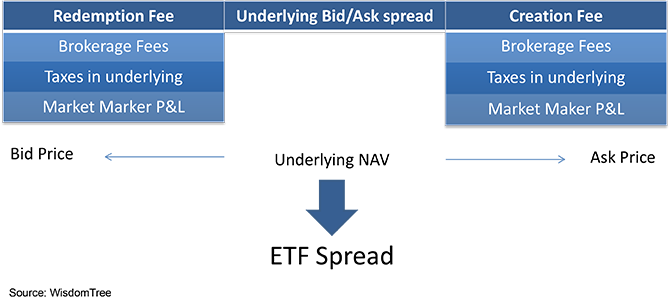The content of this post is relevant to institutional investors interested in trading ETFs in significant size. Individual investors do not always have access to liquidity providers to trade ETFs as referenced below.
I wanted to spend some time talking about
exchange-traded fund (ETF) spreads, because they are often a topic of concern for investors. A spread is merely the difference between where a
market maker will buy and sell an ETF. As a former ETF trader, market maker and
arbitrageur, I can tell you that there is a mathematical reason for an ETF spread, and each trader out there is taking into consideration costs they have to incur in order to facilitate liquidity. First, let’s clarify that when a market maker facilitates
liquidity, they look to
hedge that resulting position and then
flatten their position either by unwinding in the
secondary market (ETF on-screen liquidity) or by using the
primary market (
creation/redemption with the
ETF issuer). So if a market maker buys an ETF, they are now
long the ETF and have to sell something to hedge that position. If they sell the underlying basket of securities, their choices to unwind that position are to buy back that basket in increments as they sell the ETF in the secondary market, or to redeem the ETF to the issuer (send the ETF to the fund and receive the basket of stocks in return).
Each ETF has a maximum cost structure that a trader will have to pay to hedge their position and subsequently flatten it, and that cost structure will dictate where the spread of an ETF with low volume will start out. As volume and interest in an ETF increase, the spread of that ETF will decrease. This is because the more secondary volume there is, the higher the probability that the market maker can liquidate their position without incurring some of those costs.
Below is a list of costs that would be included in a simple spread. The term “simple” is used because this example assumes that the underlying basket of securities is trading at the same time as the ETF and the market maker is able to perfectly hedge their ETF positions with it.
•
Underlying Securities Bid/Ask Spread is the actual bid/ask spread of the stocks in the underlying basket that traders pay when trading this as a perfect hedge.
•
Create/Redeem Fees are flat administrative costs that are incurred when using the creation/redemption facility (cost exclusive to primary market). The term “flat” means that this fee is the same irrespective of the number of units the authorized participant is creating/redeeming. Keep in mind that spreads of ETFs on-screen posted by market makers are for smaller sizes—usually 1,000 shares or fewer—and thus all calculations are done based on one unit.
•
Brokerage Fees are costs associated with trading in the underlying securities. If a trader has to buy the 500 names in the
S&P Index, there are commission costs that have to be paid to their market access point or electronic platform. In the U.S., these fees can be minimal, but they increase as the asset class becomes more esoteric or harder to access.
•
Taxes in the Underlying Basket are imposed transaction taxes on certain securities in certain countries. They do not exist in the U.S., but in the U.K. , for example, regulators have imposed a .50% buy-side stamp tax for equity purchases. That means that when buying a UK equity, the buyer has to pay an additional .50% on top of the purchase price. That cost will be included in a maximum-cost scenario and thus the spread of any ETF that holds UK equities.
•
Market Maker “Profit and Loss", or P&L is a built-in commission if there is no agreement to explicitly charge for the service of providing liquidity.
Below is a visual of what the building blocks of a spread look like. All the costs a market maker would incur in selling an ETF are above “
Ask Price,” and the costs associated with buying an ETF are above “
Bid Price”; both are added to the underlying bid/ask spread. The sum of all those costs is the bid/ask spread of the ETF.

Again, this is a simple spread, and other costs will be considered in different scenarios. For example, if the underlying securities (the perfect hedge) are not open or accessible to the trader, they will then have to hedge with something else and thus incur risk from the imperfect/proxy hedge. That element of risk will be built into the spread, making it wider. Another cost that might be considered by a market maker when creating a spread is how long the position will be kept in inventory. If there isn’t a way to immediately liquidate it,
balance sheet costs would then be included, because there is a cost to tying up cash of the firm.
It’s important to understand that a spread including the maximum cost scenario is for smaller on-screen quoted sizes. If a larger size is quoted, costs such as creation/redemption fees and balance sheet costs become a smaller part of the spread, and it is thus possible to get tighter markets for larger-size trades.
An ETF spread is a function of cost. The spreads in the marketplace are not arbitrary but a formulaic combination of maximum costs and market maker assessments of the probability of incurring those costs, which are constantly changing. As assets under management and volume increase, that probability decreases, and so does, usually, the width of the spread.
Important Risks Related to this Article
All information is provided strictly for educational and illustrative purposes only. No representation is being made that any investment will achieve performance similar to those shown. The information provided is not intended for trading purposes and should not be considered investment advice. Neither WisdomTree Investments, Inc., nor its affiliates, nor ALPS Distributors, Inc., or its affiliates provide tax advice. All references to tax matters or information provided on this site are for illustrative purposes only and should not be considered tax advice and cannot be used for the purpose of avoiding tax penalties. Investors seeking tax advice should consult an independent tax advisor.


 Again, this is a simple spread, and other costs will be considered in different scenarios. For example, if the underlying securities (the perfect hedge) are not open or accessible to the trader, they will then have to hedge with something else and thus incur risk from the imperfect/proxy hedge. That element of risk will be built into the spread, making it wider. Another cost that might be considered by a market maker when creating a spread is how long the position will be kept in inventory. If there isn’t a way to immediately liquidate it, balance sheet costs would then be included, because there is a cost to tying up cash of the firm.
It’s important to understand that a spread including the maximum cost scenario is for smaller on-screen quoted sizes. If a larger size is quoted, costs such as creation/redemption fees and balance sheet costs become a smaller part of the spread, and it is thus possible to get tighter markets for larger-size trades.
An ETF spread is a function of cost. The spreads in the marketplace are not arbitrary but a formulaic combination of maximum costs and market maker assessments of the probability of incurring those costs, which are constantly changing. As assets under management and volume increase, that probability decreases, and so does, usually, the width of the spread.
Again, this is a simple spread, and other costs will be considered in different scenarios. For example, if the underlying securities (the perfect hedge) are not open or accessible to the trader, they will then have to hedge with something else and thus incur risk from the imperfect/proxy hedge. That element of risk will be built into the spread, making it wider. Another cost that might be considered by a market maker when creating a spread is how long the position will be kept in inventory. If there isn’t a way to immediately liquidate it, balance sheet costs would then be included, because there is a cost to tying up cash of the firm.
It’s important to understand that a spread including the maximum cost scenario is for smaller on-screen quoted sizes. If a larger size is quoted, costs such as creation/redemption fees and balance sheet costs become a smaller part of the spread, and it is thus possible to get tighter markets for larger-size trades.
An ETF spread is a function of cost. The spreads in the marketplace are not arbitrary but a formulaic combination of maximum costs and market maker assessments of the probability of incurring those costs, which are constantly changing. As assets under management and volume increase, that probability decreases, and so does, usually, the width of the spread.

